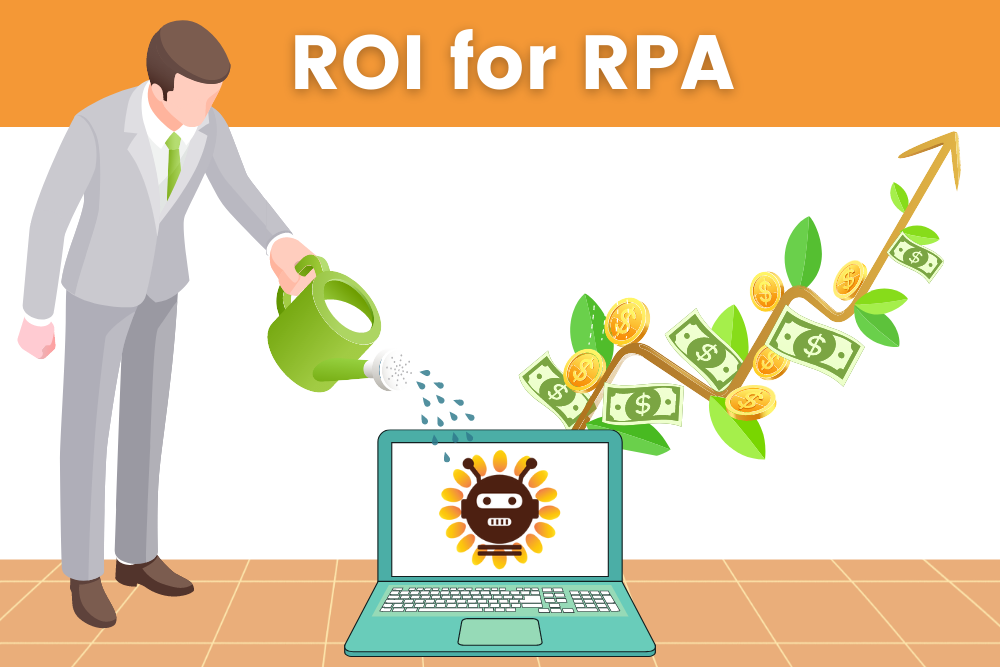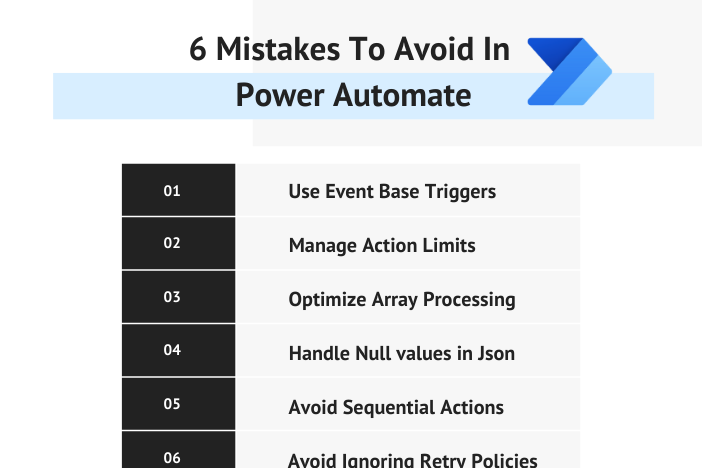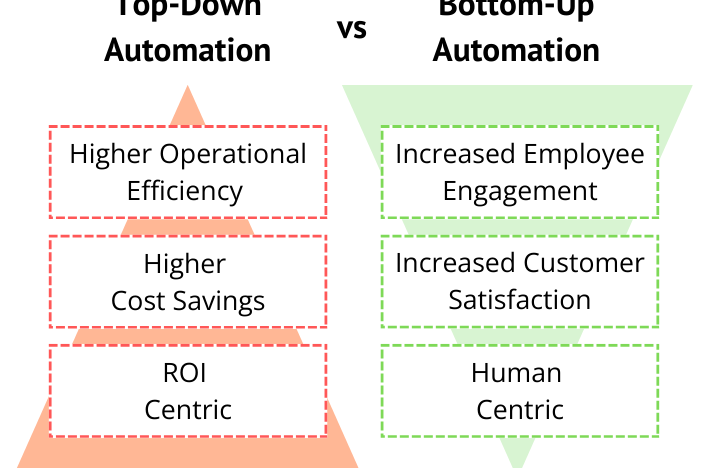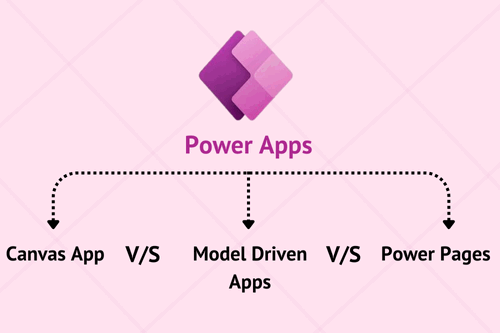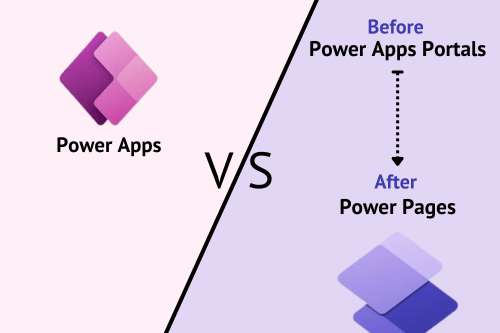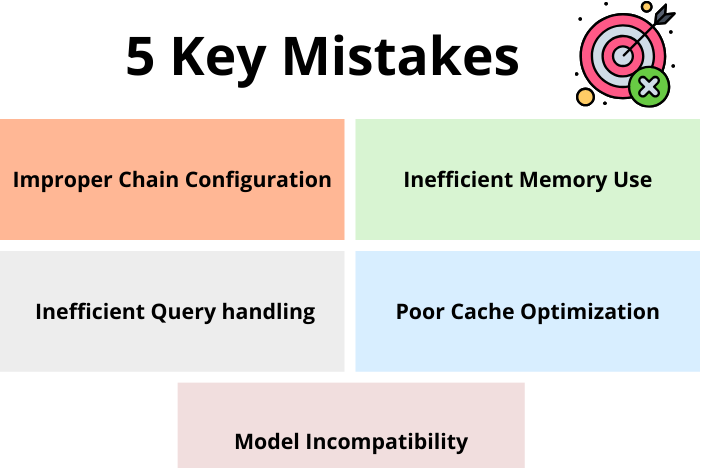Deciding to invest in robotic process automation software, or RPA, for your enterprise is a major step towards improving your business operations. It is a powerful tool for increasing innovation and productivity while also saving time and money. Additionally, it has gained a reputation for fast ROI if used correctly. In fact, The Institute for RPA estimates that RPA solutions can deliver an immediate savings of 25% to 40% in labor costs alone. McKinsey Digital also found that automating business processes with RPA can result in an ROI of between 30 and 200 percent in the first year. So how can your organization capture this level of success with RPA? Let’s find out!
What is Robotic Process Automation?
Robotic process automation is the use of software with artificial intelligence (AI) and machine learning capabilities to handle high-volume, repeatable tasks that previously required humans to perform. These tasks can include queries, calculations and maintenance of records and transactions. RPA technology, sometimes called a software robot or bot, mimics a human worker, logging into applications, entering data, calculating and completing tasks and logging out. Robotic process automation software is not part of an organization’s IT infrastructure. Instead, it sits on top of it, enabling a company to implement the technology quickly and efficiently — all without changing the existing infrastructure and systems.
Why choose Robotic Process Automation Service
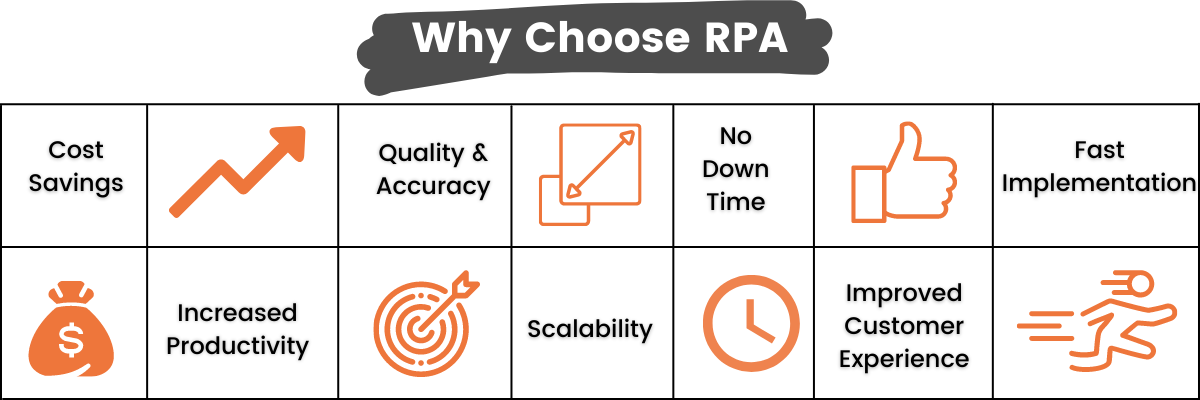
RPA can help in automating processes, thereby not only executing transactions faster but also with a higher degree of accuracy resulting in higher customer satisfaction. In the field of data management, RPA has a tremendous ability to collect, integrate, analyze, and process the torrents of data generated in today’s commercial world. Robotic process automation can be used to tackle the repetitive, easy tasks that plague customer service representatives, thereby freeing them to deliver a higher-quality experience to customers. RPA can update customer profiles, pull up billing data, and other mundane tasks that would otherwise consume customer service reps’ time. Here’s a quick look at the benefits of robotic process automation:
- Cost Savings
One of the significant benefits of robotic process automation (RPA) is the rapid decrease in operational costs it offers. By automating routine and repetitive tasks, companies can see a noteworthy reduction in expenses in a short period. Moreover, software robots operate at a fraction of the cost of a full-time employee, not requiring benefits, sick leave, or vacation time.
- Increased Employee Productivity
Robotic Process Automation (RPA) is changing the game by handling the boring, repetitive tasks that used to slow down employees. This frees them up to spend more time and energy on making better connections with clients, managing relationships, and doing tasks that need human creativity. This change makes the workforce more efficient and productive, and it also makes jobs more satisfying.
- Quality & Accuracy
Robots reduce the cases of re-work and enhance quality. The vital part is that robots follow rules exactly thereby producing 100% accuracy. Software bots aren’t prone to human error and they don’t get tired or distracted. There are no typos and no entries going in the wrong field
- Improved Customer Experience
By using Robotic Process Automation (RPA), companies can relieve their expensive resources from doing routine and repetitive tasks. This change allows these valuable assets to focus on more important, innovative work, especially improving customer support and engagement. This smart move not only makes operations more efficient but also greatly enhances service quality.
- RPA is scalable
Using robotic process automation helps businesses adjust easily to seasonal needs. This tech allows them to scale operations up or down smoothly, making their processes more efficient and adaptable. It boosts operational flexibility and cuts down on the manual work and costs that usually come with traditional scaling.
- No Down-Time
Software bots are designed to operate continuously, without any breaks, 24 hours a day, every single day of the year, including holidays and weekends. They can function at 100% capacity throughout this time, efficiently handling tasks without the need for rest or downtime that human workers would require.
- Fast Implementation
Putting a new Robotic Process Automation (RPA) system to work is much quicker than training a new employee. Take setting up data entry software bots as an example—they can be up and running in a few days. This fast setup feature of RPA not only saves time but also lets businesses scale up quickly and make tasks usually slow and error-prone more efficient and reliable.
RPA Fast Facts
Accelerated transformation
The robotic process automation (RPA) market was estimated to be worth 3.7 billion U.S. dollars in 2022. This market is forecast to grow with a CAGR of 36.6 percent from 2022 to 2032. The market size is expected to be valued at 81.8 billion U.S. dollars by 2032. (Statista)
Major cost savings
Savings of up to 25-80% on current operational costs. As an example, RPA can cut costs for financial service companies by up to 70% (Anyrobot)
Greater resilience
- Employees spend 10%-25% of their time on repetitive computer tasks.
- IT departments spend 30% of their time on basic low-level tasks
- 50% of companies spend between $5- $25 dollars for manual invoice processing
- A typical rules-based process can be 70%-80% automated.
Source: Automation Anywhere
Improved compliance & higher accuracy
92% of manufacturers report that RPA helped them improve compliance, and 90% say that RPA has enhanced quality and accuracy. (Flobotics)
Boosted productivity
79% of workers name increased productivity as one of the main benefits of using automation. (Salesforce)
More value from personnel
83% of employees using AI-powered automation believe that it can help reduce burnout and enhance job satisfaction. (UiPath 2023 Automation Generation Report)
Happier employees
91% of employees admit that automation saves time and improves work-life balance as new Salesforce research links lower stress levels and business automation
What Companies are Using RPA?

Walmart, Deutsche Bank, AT&T, Vanguard, Ernst & Young, Walgreens, Anthem and American Express Global Business Travel are among the many enterprises adopting RPA.
Walmart CIO Clay Johnson says the retail giant has deployed about 500 bots to automate anything from answering employee questions to retrieving useful information from audit documents. “A lot of those came from people who are tired of the work,” Johnson says.
David Thompson, CIO of American Express Global Business Travel, uses RPA to automate the process for cancelling an airline ticket and issuing refunds. Thompson is also looking to use robotic process automation to facilitate automatic rebook recommendations in the event of an airport shutdown, and to automate certain expense management tasks.
“We’ve taken RPA and trained it on how employees do those tasks,” says Thompson, who implemented a similar solution in his prior role as CIO at Western Union. “The list of things we could automate is getting longer and longer.”
How to Calculate ROI for RPA
ROI, or “Return on Investment,” is a project’s expected return in percentage terms. ROI is a critical tool for measuring the impact of your RPA investment with real data. With an understanding of your robotic process automation initiative’s ROI, you can:
- Justify the initial investment to business leaders with data-driven evidence
- Make strategic decisions about the technology during planning
- Plan and build support for subsequent investments like expanding your RPA solution
- Improve and scale your RPA solution more effectively for better results
- Feel confident that your solution is performing at its highest potential and delivering optimal value to your company
It is important to remember that there is more than one way to look at how robotic process automation benefits a business. There is the financial benefit, of course, but there are also more intangible benefits such as employee morale or vendor relationship management. In order to get a complete picture of the ROI of RPA, we must look at the financial costs, potential benefits, and how to factor in the human part of the equation.
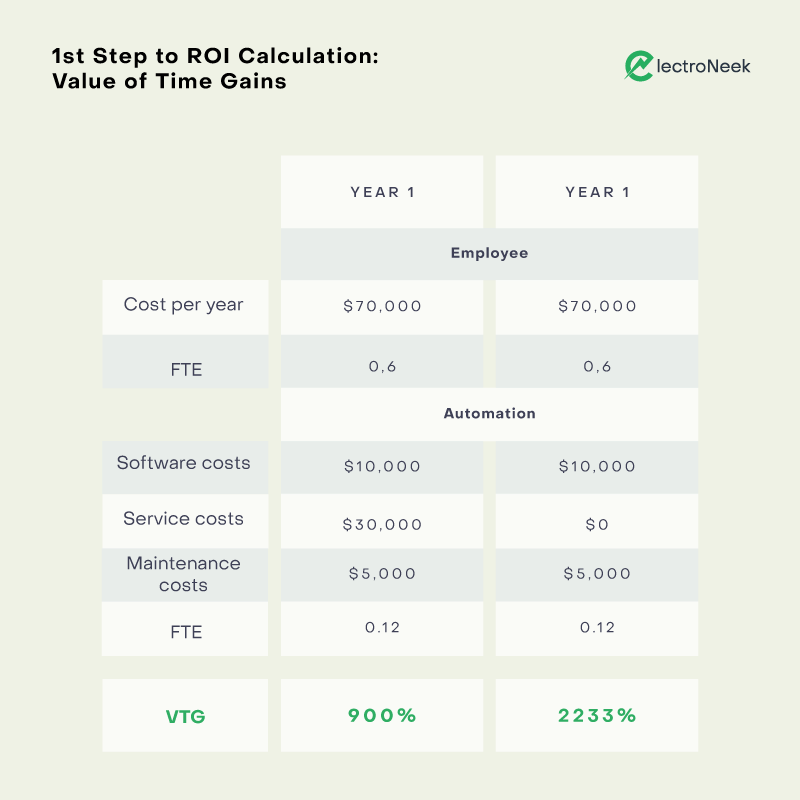
Other Factors to Consider When Calculating ROI for RPA
- Employee Satisfaction
- Customer Service Availability and Quality
- Better Business Agility
- Full Time Equivalent
- Process Lead Time
- Hours Back to Business
- Business Continuity Impact
- Savings from Increased Accuracy
- Elimination of downtime risks
To Evaluate the ROI in RPA – we compare the Return vs Investments. All the factors mentioned above are considered to be the Return.
Factors that Account for Investment
- RPA software cost – Automation tool
- Implementation cost – Infrastructure
- Annual maintenance
- Training for Employees and Experts
- The cost of development;
- The cost of monitoring and maintenance
Choosing an RPA for your Business
Are you looking to save time and money on your business operations? Are many of your business processes rule-based, repetitive, and flow at high volumes? Do you want to utilize your employees for more valuable tasks to elevate the quality of your outputs? If you answered yes to any or all of these questions, your enterprise may be a great candidate for robotic process automation. Contact us today
You might also like
Stay ahead in tech with Sunflower Lab’s curated blogs, sorted by technology type. From AI to Digital Products, explore cutting-edge developments in our insightful, categorized collection. Dive in and stay informed about the ever-evolving digital landscape with Sunflower Lab.


